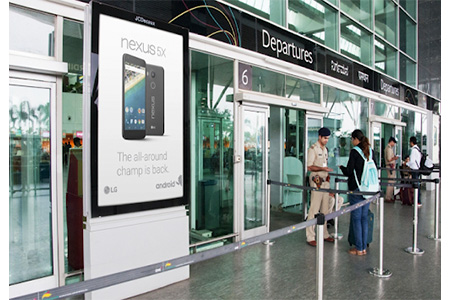The Evolution of Airport Advertising: From Static Billboards to Digital Innovation

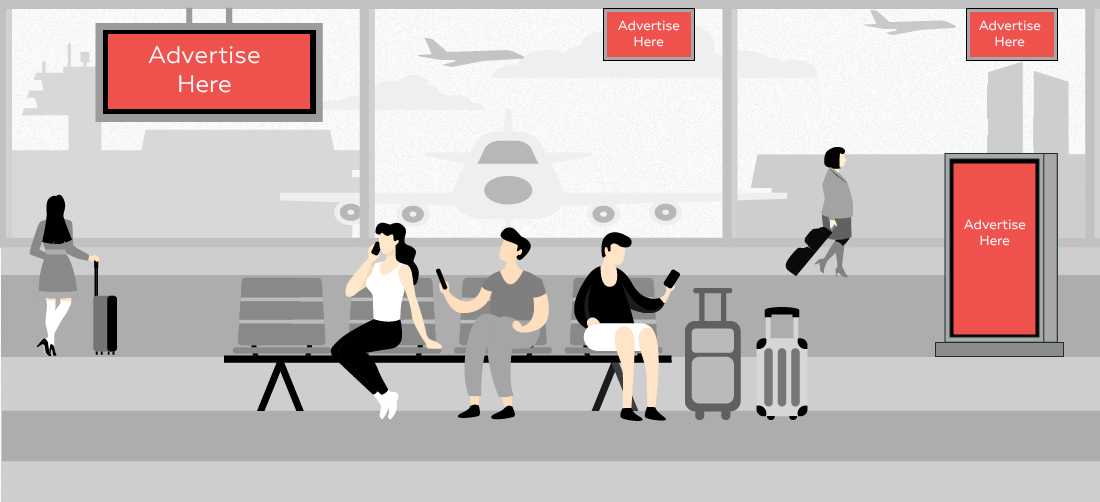
Table Of Content
- 1. The evolution of airport advertising from static billboards to digital innovation
- 2. How airport billboard advertising has transformed into a digital powerhouse
- 3. Airport digital advertising revolutionizes the passenger experience in terminals
- 4. The transformation of airport terminal advertising from static to dynamic solutions
- 5. Exploring the shift in airport advertising from billboards to interactive digital displays
- 6. Conclusion
Introduction (Header for the below content)
Advertising in the airports has taken a new face, where it is not a simple billboard but an interactive digital board. It has transformed the way brands interact with travelers on the real-time content and consequently improved the passenger experience. The change to the digital innovation in the airports has brought with it more effective advertising that is personalized and has a greater impact on the brands that communicate to the global audience.
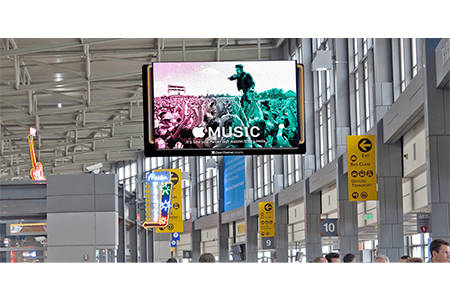
Importance of Airport Advertising
Captive Audience Reach
Airport advertising is unique since travelers spend considerable time in the waiting lounge while waiting for flights, baggage, or services. It presents a captive audience that will be more inclined to notice and react to airport ads. Whether it is an airport billboard, lounge display or digital sign, these ads in airports command undivided attention. The unique setting reduces distractions and messages are more likely to be remembered. The brands will get more time to be seen, which will ensure effective stories that will resonate with travelers regardless of demographics.
High Brand Visibility
Airports are global hubs that see millions of individuals daily, and thus airport billboard commercials are a one-of-a-kind and unparalleled device of visibility. In the airports and lounges, advertisements are placed strategically in high-traffic areas. The marriage of computer monitors and creative airport advertising will ensure that the messages are reinforced to the travelers while they are at the airport. The visibility here does not change, strong and believable, unlike other mediums. For brands, it's not about exposure but positioning in the upscale environment enhances recognition.
Influences Travel Decision
The developed airport advertisements can influence the purchasing behavior and travel choice. Innovative airport advertising as a means of promoting luxury brands and stimulating local activity will draw attention at high-intent points. Passengers' last-minute buying decisions are usually brought about by airport advertisements, whether in the duty-free or tour bookings, or upgrading procedures. The linkage of messages to the requirements of passengers makes airport ads credible stimuli that will lead to genuine action, enhancing brand engagement and customer satisfaction.
Enhances Customer Experience
Advertising in the airports is no longer just the visibility but also enhances passenger experience. Interactive digital airport advertising, the availability of lounges, and the airport TV advertisement provide engaging information and engaging and interesting real-time content. When the ads are tailored to the requirements of the traveler, they don't feel intrusive and are rather a value addition. This blending provides a balanced mix of customer experience and brand communication. Done correctly, airport advertising will turn waiting time into a valuable, memorable brand experience.
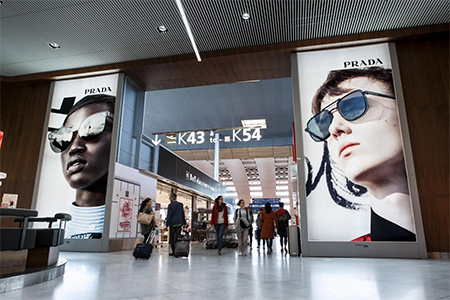
Benefits of Airport Advertising
Wide Audience Exposure
Airports have a wide range of business travelers, tourists and foreign visitors, thus making them a special place to be able to cover a wide audience. Airport terminal advertising is effective in ensuring that messages reach people with different demographics within one setting. Unlike traditional billboards, the billboard advertising in airports benefits from having longer dwell times, which ensures multiple impressions. Airport advertisement can be employed strategically to target millions of individuals across the globe, thus making airports among the most efficient ways of enhancing brand presence across borders.
Increased Brand Recall
Airport ads allow a brand to segment and reach the audience. For instance, airport lounge advertising reaches the upscale traveler, with airport TV advertising reaching passengers in the waiting bays. Advertisers can create more relevant campaigns with data driven strategies, where one can personalize campaigns based on the profiles of travelers. Airport digital advertising uses flexibility to switch messages on the spot, unlike the traditional billboards. This renders airport advertising an important decision when a brand requires maximizing its ROI and remaining contextually viable.
Targeted Marketing Opportunities
Airport ads enable brands to target and segment audiences efficiently. Airport lounge advertising, for instance, addresses upscale travelers, whereas airport TV advertising addresses waiting-area travelers. Based on data-driven approaches, advertisers can tweak campaigns based on traveler profiles to gain maximum relevance. Unlike fixed billboards, airport digital advertising enables marketers to modify messages dynamically in real time. This position's airport advertising as a strategic option for marketers who wish to spend their money efficiently without sacrificing contextual relevance.
Boosts Sales and Engagement
The airport advertisement can benefit the sales directly by the effect of the duty-free offer and the regional attractions since these advertisements can influence the passengers directly at the right moment. To be reached and to act is what creative airport advertising accomplishes to buy spontaneously or to reserve upgrades. Airport lounge advertising is also used to create more intense connections with the provision of immersive brand experiences in high-end settings. Primarily outside of sales, interactive campaigns encourage conversations and emotional connections, enhancing a brand's overall perception. Airport advertising is not exposure it is conversion-driven.
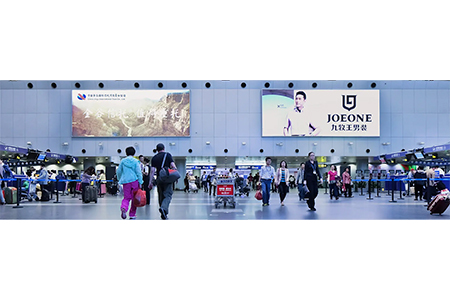
Challenges of Airport Advertising
High Advertising Costs
The cost of advertising in the airports is one of the largest hurdles, as it is comparatively very high compared to most of the traditional media. The elevated prices have been a reflection of the selective audience and high-value nature airports attain. Advertising in the airports can be pricey, but the rewards of being noticed and engaged may be worth it. However, for smaller brands, there might not be an easy time to compete with big players in airport billboard advertising and budget strategy and ROI tracking prior to commissioning the suggested concept.
Limited Ad Space Availability
Terminal advertising is in great demand, and therefore there is very little space available and it is highly competitive. Boarding gate stands, baggage claim stands or even lounges can be booked months in advance. This shortage contributes to the ad cost in the airports, and this in turn restricts the availability of new brands. With fewer options, advertisers need to employ as much imagination and strategic placement as they can in order to cut through. Despite this, the airport billboard advertising has exclusivity that provides prestige, which enhances the brand image in a saturated market.
Strict Airport Regulations
Airports are highly regulated environments and any advertisement put in airports should adhere to the strict regulations. Approvals of content to the rules of placement there are controls on brands that can restrict creativity. Installation and implementation are also influenced by security protocols and therefore flexibility becomes challenging. While the rules give security and predictability, they have the potential to dilute campaigns compared to other platforms. The advertisers then have to find the right balance between following and inventing in order to create a good but tolerable airport ad without compromising brand storytelling.
Audience Distraction and Fatigue
Airports are the perfect location to locate a captive audience, but the effect of advertisements can be diminished due to distractions like flight delays, announcements, and travel anxiety. The fatigue from frequent flyers may actually be due to repeatedly seeing the advertisement on the airport board. This is where innovation comes in, only the greatest airport ads connect amidst constant stimulus. In response to this, brands are now gravitating towards interactive airport digital marketing and immersive experiences that grab attention so travelers don't feel ignored on their journey.
The Evolution of Airport Advertising
Early Static Displays and Print Ads
Advertising at the airport began with the utilization of the static billboard, posters, and print displays that were placed in the terminals. These traditional formats were the core of the airport billboard advertising since they granted brands simple but efficient exposure to the travelers. They were not that innovative but provided consistent visibility. Over time, the travelers grew accustomed to these advertisements at airports, and thus came the need to innovate. Simple as they were, these initial advertisements proved that airports could be robust commercial areas, not just transit points.
Introduction of Digital Signage and Screens
The growth of digital advertising within the airports was a significant shift in strategy. Static screens were replaced by dynamic screens filled with colorful matter. In contrast to the classical airport billboard advertisement, digital signage offered real time updating, flexibility, and greater interactivity. Airport television advertisements on terminal digital walls offered more room for creativity to the brands. This shift raised the visual stimulation and customer engagement and made airports extremely immersive and technologically infested advertisement hubs.
Integration of Interactive and Personalized Advertising
With the technological advancement, airports embraced individualized and interactive campaigns. New airport advertising began incorporating touchscreens, QR codes, and mobile integrations to enable passengers to engage with brands. Personalized ads based on travelers made the content more relevant, raising engagement levels. The airport lounge advert or the immersive screens would bridge the gap between consumer and brand. The evolution transformed the classic airport advert of a classic screen into an interactive brand experience.
The Role of Data Analytics and Programmatic Ads in Airports
Airport advertising is transformed with data analytics, as it makes targeting individuals with accuracy and campaign optimization possible. Passenger profiles, route information, and behavior are used by the brands now to offer personalized airport ads to the passengers. The programmatic advertising facilitates real-time adjustment, which maximizes the ROI and reduces the waste. Strategy driven by data keeps the campaigns topical, whether in airport digital marketing or interactive screens. This shift makes the ads in airports not just stunning but also smart and performance measurement focused.
Future Trends in Airport Advertising
Artificial Intelligence and Machine Learning
AI will also revolutionize the advertising at airports by making it hyper-personalized. AI-driven campaigns will revolutionize the process of engagement, be it forecasting the activities of travelers or offering them real-time deals. Machine learning facilitates the optimization of the advertisement price in airports based on the outcome of the performance and audience analytics. Smarter ad placements, automatic refresh, and predictive targeting can be expected by the brands. This ensures the effectiveness of creative airport ads in a manner that assists in boosting ROI. The future of airport advertising lies in AI-powered accuracy that will transform airports into an intelligent marketing platform.
Augmented Reality (AR) and Virtual Reality (VR)
The airport advertising innovation of the future is being designed by AR and VR. These technologies make for memorable brand experiences, either in the form of in-lounge advertising or interactive terminal experiences. Passengers can either see products virtually or experience 3D campaigns as they wait. Unlike the traditional airport billboard promotion, AR/VR is a more experiential way of storytelling that enhances recall and emotional connection. The best airport ads will be those that encourage viewers to engage actively instead of passively absorbing airport commercials as they approach.
